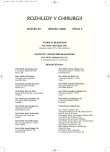Robotic Procedures in the Colorectal Surgery
Authors:
P. Vlček; I. Čapov; V. Jedlička; Š. Chalupník; J. Korbička; L. Veverková
; J. Doležel; J. Jeřábek; J. Wechsler
Authors‘ workplace:
I. chirurgická klinika FN u sv. Anny v Brně, přednosta: prof. MUDr. I. Čapov, CSc.
Published in:
Rozhl. Chir., 2008, roč. 87, č. 3, s. 135-137.
Category:
Monothematic special - Original
Overview
Purpose:
The da Vinci® surgical system (Intuitive Surgical, Sunnyvale, CA, USA) was developed specifically to compensate the technical limitations of laparoscopic instruments, such as two-dimensional vision, misalignment of hands and instruments, limited dexterity of instruments inside the patient, and fixed instrument tips. The da Vinci® system provides a stable camera platform, three-dimensional imaging, excellent ergonomics, tremor elimination, ambidextrous capability, motion scaling, and instruments with multiple degrees of freedom.
Methods:
These advantages can be applied in the field of colorectal surgery, and that’s why we are reporting 45cases that underwent robotic colorectal surgery. We concluded that the da Vinci® system may be useful in surgical procedures, such as splenic flexure takedown, dissection of the inferior mesenteric artery with identification of the nervous plexus, and dissection of a narrow pelvis.
The major drawbacks of robotic systems are high cost, and a lack of tactile sensation and tensile feedback to the surgeon, who must depend on visual cues to estimate the tension exerted on tissue by the robotic arms.
Results:
In conclusion, robotic colorectal surgery can be performed safely and effectively, using the da Vinci® surgical system, because this system has more dexterity and flexibility than conventional laparoscopic instruments. However, prospective randomized studies are necessary to evaluate the preservation of sexual and voiding function, as well as the oncological and functional (pelvic floor disorders) outcomes of this approach.
Key words:
robotic surgery – colorectal surgery – rectal cancer – pelvic floor disorders
Sources
1. Weber, P. A., Merola, S., Wasielewski, A., et al. Telerobotic-assisted laparoscopic right and sigmoid colectomies for benign disease. Dis. Colon Rektum, 2002; 45 : 1689–1694.
2. Giulianotti, P. C., Coratti, A., Angelini, M., et al. Robotics in general surgery: personal experience in a large community hospital. Arch. Surg., 2003; 138 : 777–784.
3. Vibert, E., Denet, C., Gayet, B. Major digestive surgery using a remote controlled robot: the next revolution. Arch. Surg., 2003; 138 : 1002–1006.
4. Corcione, F., Esposito, C., Cuccurullo, D., et al. Advantages and limits of robot-assisted laparoscopic surgery: preliminary experience. Surg. Endosc., 2005; 19 : 117–119.
5. Woeste, G., Bechstein, W. O., Wullstein, C. Does telerobotic assistance improve laparoscopic colorectal surgery? Int. J. Colorectal Dis., 2005; 20 : 253–257.
6. D’Annibale, A., Morpurgo, F., Fiscon, V., et al. Robotic and laparoscopic surgery for treatment of colorectal disease. Dis. Colon Rektum, 2004; 47 : 2162–2168.
7. Ballantyne, G. H. Robotic surgery, telerobotic surgery, telepresence, and telemonitoring. Review of early clinical results. Surg. Endosc., 2002; 16 : 1389–1402
8. Hanly, E. J., Talamini, M. A. Robotic abdominal surgery. Am. J. Surg., 2004; 188 : 19S–26S.
9. Korbička, J.,Vlček, P., Čapov, I.,Wechsler, J. Functional Results of Anal Sphincter Repair:Post obstetric and Fistula-related Injury. Abstracts of 9th Biennial Congress of the European Council of Coloproctology ECC, Athens 2003, in:Techniques in Coloproctology, Springer 5/2003, Vol 7/Supplement 1/: S49
10. Vávra, P., Dostalík, J., Martínek, L., Guňka, I., Plevová, P., Guňková, P., Vávrová, M. Laparoscopic colectomy for familial adenomatous polyposis. Surg. Endosc., 2005, 19, 93.
11. Munoz, Y., Mouchy, K., Kudchadkar, R., Hernandez, J., Martin, S., Darzi, A., Rockall, T. Robotic assisted rectopexy. Am. J. Surg., 2004, Jan; 187(1): 1–9.
12. Ayav, A., Brazlet, L., Hubert, J., Brunaud, L., Boissel, P. Robotic-assisted pelvic organ prolapse surgery. Surg. Endosc., 2005 Sep; 19(9): 1200–1203
Labels
Surgery Orthopaedics Trauma surgeryArticle was published in
Perspectives in Surgery

2008 Issue 3
- Metamizole at a Glance and in Practice – Effective Non-Opioid Analgesic for All Ages
- Metamizole in perioperative treatment in children under 14 years – results of a questionnaire survey from practice
- Obstacle Called Vasospasm: Which Solution Is Most Effective in Microsurgery and How to Pharmacologically Assist It?
- Possibilities of Using Metamizole in the Treatment of Acute Primary Headaches
Most read in this issue
- Zenker’s Diverticle – Surgical Management
- Scar Hernia Repairs Using a Mesh – The Sublay Technique
- Diagnostics of the Retrocalcaneal Bursitis: Possibilities of the Use of New Anatomical Data
- Central Cervical Dissection of Lymphonodes in the Management of Differentiated Thyroid Carcinoma – Our Experience
